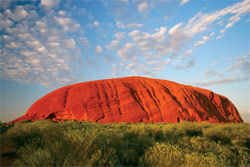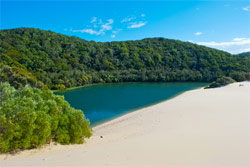Think of Australia and you’ll immediately conjure up images of kangaroos, koalas, white beaches, and of course Crocodile Dundee. The country is known for having an abundance of wildlife and stunning natural scenery. It also has a rich Aboriginal culture.
And while most people think of Australia as one very big island, it’s actually surrounded by 8,222 smaller islands. There’s the island state of Tasmania, the world’s largest sand island, Fraser Island, and even a territory down in Antarctica. A number of the islands are named after animals – among them are Kangaroo Island, Cockatoo Island and Lizard Island.
Covering just under 3,000,000 square miles, Australia is the sixth largest country in the world. And with such a wide variety of landscapes, including tropical rainforests, mountain ranges and desert, there’s a lot to see!

Uluru, which is also known as Ayers Rock, is one of Australia’s most striking natural wonders. This huge sandstone rock formation located in the Northern Territory draws in hoards of tourists each year. It protrudes 348 meters above the dessert and has a circumference of just under six miles. But it’s not only beautiful to look at; it’s also very spiritually significant to the local Aboriginal people. The area surrounding Uluru is pretty special too – there are springs, waterholes, rock caves and ancient paintings.
And just 18.6 miles down the road you’ll find Kata Tjuta, which is also known as The Olgas. It comprises 36 rounded red domes – the word Kata Tjuta actually means ‘many heads’ – the highest of which is in the vicinity of 546 meters. Estimated to be around 500 millions years old, these ancient rock formations are also sacred to the local Aboriginal people.
And from huge, sandy rocks, we move onto the watery wonder that is the Great Barrier Reef. Not only is it an Aussie wonder, but it’s also one of the seven natural wonders of the world. The crystal clear waters of the reef are teeming with marine life. And lucky for visitors, there are also plenty of ways to enjoy them: snorkeling, scuba diving, aircraft or helicopter tours, bare boats, glass-bottomed boats, cruise ship tours, whale watching, and you can even swim with dolphins.
Located off the north coast of New South Wales, Lord Howe Island is a World Heritage-listed paradise. Picture long, pristine-white beaches, crystal-clear waters filled with rare corals, and rugged mountains populated by rare exotic birds. Yep, the word ‘paradise’ has not been used lightly. In fact, Lord Howe Island is known as one of the most beautiful islands in the Pacific. Only 400 people can visit the island at a time, which means travelers get a true island experience. As you can imagine, the island is big on water-based activities, which include scuba diving, fishing, snorkeling, surfing and kayaking.
While we’re on the subject of beautiful paradise islands, we can’t leave out another World Heritage-listed island: Fraser Island. As the world’s second-largest sand island, expect to see sand. But not just any sand; Fraser Island has some of the purest silica sand in the world – so pure it can be used to polish jewellery. Hike inland and you’ll stumble across the beautiful Lake McKenzie, whose waters are so clear that they’re unsuitable for many species. Although there are hotels on the island, many people prefer to commune with nature in a tent or eco-friendly resort.
Kakadu National Park is a protected area in Australia’s Northern Territory. It’s a place of adventure and culture, with the landscape largely untouched and much of the local Aboriginal heritage still intact. Due to its rich cultural elements, the park is popular with families. It covers a sizeable area of 7,646 square miles, so a few days in the park are recommended. Among other things, you can see the famous plunge waterfall Jim Jim Falls, take a boat cruise or scenic flight, go crocodile spotting, and see ancient paintings and rock art – much of which dates back over 20,000 years.

And now south to Maria Island – the mountainous island located off the east coast of Tasmania. The whole of Maria Island is a World Heritage-listed national park, which means you can expect some serious untouched natural beauty here. There are no motor vehicles and no shops. Among the thriving wildlife are whales, dolphins, Tasmanian devils and countless birds. The Maria Island walk, which is a gentle, four-day guided walk, is known as one of the world’s greatest walks – it has won seven national and 12 state tourism awards. There are also historic ruins and tall limestone cliffs harboring countless fossils.
Head south out of Melbourne to hit the Great Ocean Road – a dramatic coastline with a range of beautiful scenery ranging from craggy limestone stacks to rainforests and old volcanoes. The whole road is 151 miles long and is listed as an Australian National Heritage site. Beginning at Torquay and ending up at Allansford, key stop-off points include those aforementioned limestone stacks, which are called the Twelve Apostles, the iconic surf spot Bells Beach, and Great Otway National Park, which features some of Australia’s best rainforest scenery.
MacKenzie Falls is the largest waterfall in Victoria. Apart from being beautiful, the waterfall is also famous for being one of only a handful that actually flows all year-round. The falls are located a two-hour- and 55-minute drive northwest of Melbourne.
And back up to New South Wales, we can’t leave out the stunning Blue Mountains. This epic mountain range gets its name from the characteristic blue haze that’s created by the eucalyptus oil that’s released from the area’s many gum trees. Here, you can relax in the lakes of a unique bathhouse, or for more of an action-packed adventure, canyon, climb, abseil, bushwalk or mountain bike through the area’s varied landscape. There are also numerous renowned restaurants where you can indulge in a bit of fine wining and dining.
It seems that everywhere you look in Australia there’s something beautiful to do or amazing things to see. The country’s multiple unique ecosystems make for a vast array of stunning scenery. So much of the natural landscape has been protected and preserved, allowing people to see a level of untouched beauty that can be hard to find today. Add to that a rich and unique culture, which can be seen in elements such as original rock paintings in ancient caves, and you can’t deny that Australia is most definitely a land of natural and cultural treasures.






 PASSPORT & VISA PROCESSING
PASSPORT & VISA PROCESSING